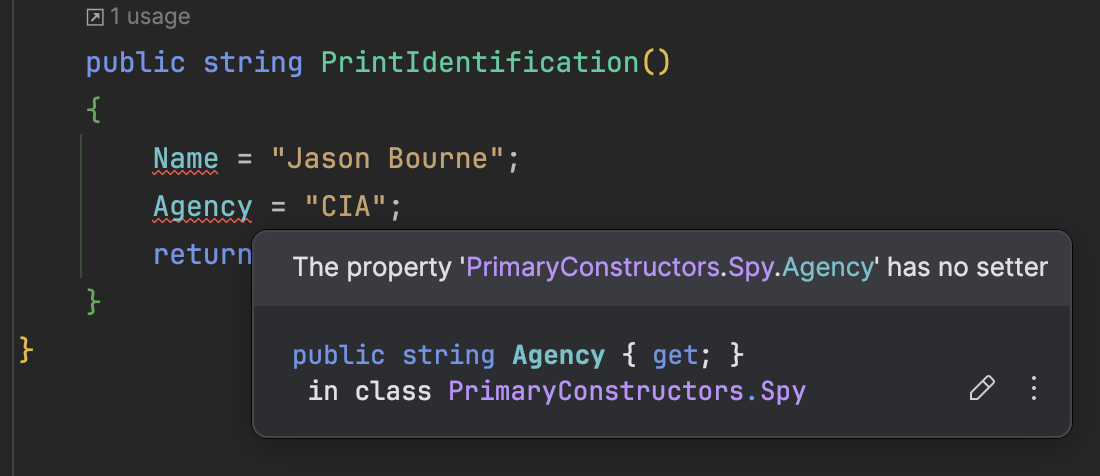Primary Constructors - And Their Pitfalls
[C#, .NET]
When declaring a type, you typically create it with a constructor, which initializes any state necessary for the class to carry out its intended functions.
Let us take, for example, the following simple type:
public sealed class Spy
{
public string Name { get; }
public string Agency { get; }
public Spy(string name, string agency)
{
Name = name;
Agency = agency;
}
public string PrintIdentification()
{
return $"Name: {Name}; Agency: {Agency}";
}
}
We can then write a simple program to demonstrate that everything works.
var spy = new Spy("James Bond", "MI-6");
You should see the following in your console.
Name: James Bond; Agency: MI-6
One of the new features added to .NET 8 was primary constructors.
This is a feature that allows the previous class to be re-written like this:
public sealed class Spy(string Name, string Agency)
{
public string PrintIdentification()
{
return $"Name: {Name}; Agency: {Agency}";
}
}
The code, unsurprisingly, still functions as expected.
Name: James Bond; Agency: MI-6
A primary constructor allows you to specify constructor parameters in the class definition itself, thus avoiding creating your own constructor as a method within which you perform any necessary initialization. The rationale here, I would imagine, is for developers to have less boilerplate code to write.
Are these types the same? They certainly look the same.
The answer is no.
In our type with the primary constructor, we can do the following:
public sealed class Spy(string Name, string Agency)
{
public string PrintIdentification()
{
Name = "Jason Bourne";
Agency = "CIA";
return $"Name: {Name}; Agency: {Agency}";
}
}
This, unsurprisingly, prints the following:
Name: Jason Bourne; Agency: CIA
In other words, the parameters are mutable.
We cannot do this in the type with the normal constructor - we get a compiler error.

Mutable parameters have the disadvantage that you can very easily inadvertently introduce bugs into your code by changing state when it was not meant to be changed.
Luckily, there is somewhat of a solution to this.
We can re-write our type like this:
public sealed class Spy(string Name, string Agency)
{
private readonly string _name = Name;
private readonly string _agency = Agency;
public string PrintIdentification()
{
return $"Name: {_name}; Agency: {_agency}";
}
}
Here, we can signify our intent by using the primary constructor to initialize private, readonly fields, which cannot themselves be modified.
The caveat here is that the developers working on the code must remember to always use the private, readonly fields throughout the type and not the primary constructor parameters, which are still available throughout the class!
In other words, it is still possible to accidentally do this:
public sealed class Spy(string Name, string Agency)
{
private readonly string _name = Name;
private readonly string _agency = Agency;
public string PrintIdentification()
{
Name = "Jason Bourne";
return $"Name: {Name}; Agency: {_agency}";
}
}
Is this something that I will be using personally?
The fact that there is much less code to type is very attractive. However, using a proper IDE like JetBrains Rider (my IDE of choice), Microsoft Visual Studio or even Microsoft Visual Studio Code, generating a constructor, read-only private fields, or read-only public properties is pretty trivial.
If you haven’t experienced this in any of the IDEs I have mentioned, create an empty class and within the class definition, type ctor. You can then add parameters to the generated empty constructor, and the IDE will prompt you whether to create private, read-only fields or public read-only properties.
I do not feel that less typing is an acceptable price for the risk of accidentally mutating parameters you did not mean to.
TLDR
Primary constructors, introduced in .NET 8, can save you some boilerplate code. However be very careful that you do not inadvertently mutate the parameters within the body of your class.
Happy hacking!